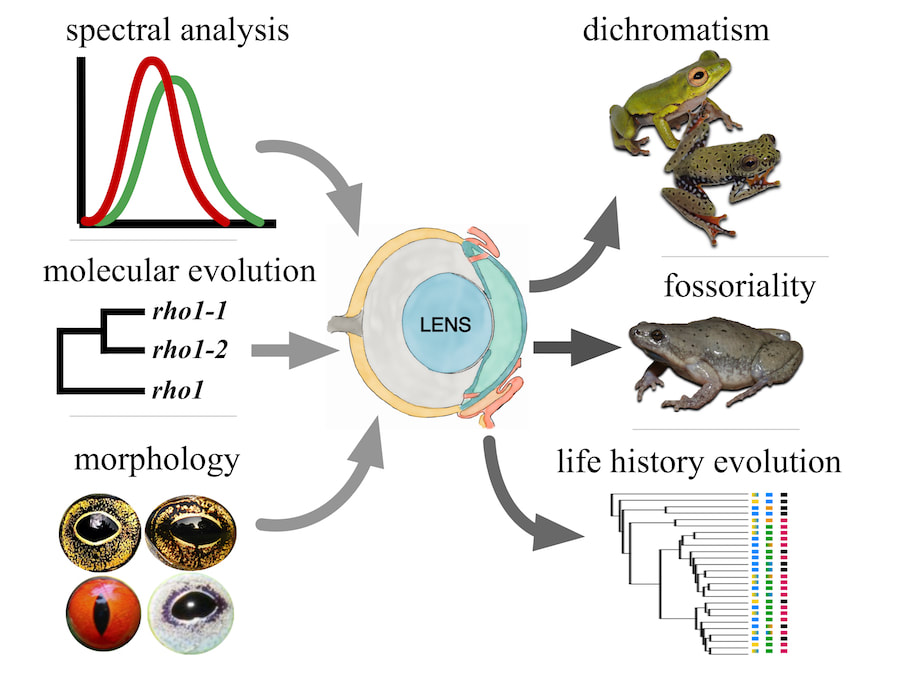The evolution of visual systems during major life history transitions in frogsAs an interface between the environment and the organism, vision plays a pivotal role in shaping ecological characteristics and complex behaviours, such as mate choice and species recognition. Thus, understanding how visual systems function and evolve can provide vital insight into the diversity of ecological transitions that have occurred across the animal tree of life. Frogs are especially well suited to understanding adaptive evolution of visual systems because major ecological transitions have occurred repeatedly in this diverse group (>6,600 extant species). This includes multiple independent origins of diurnal activity, fossoriality, and sexual dichromatism, all of which are expected to influence the evolution of the vision system.
Logo credit: Matthew Fujita |
Project overview
|
The goal of this project is to understand the physiological, genetic, and morphological trends of vision system evolution during evolutionary transitions throughout the frog tree of life. To first understand vision systems at a broad scale, this project will collect morphological and microspectrophotometry data across 27 families to generate a comprehensive appreciation of vision diversity and evolution in frogs. Molecular evolutionary studies will provide a genomic perspective on vision evolution with the expectation that visually-oriented frogs exhibit greater levels of natural selection, gene duplication, and retention of vision genes. Characterising the physiology and molecular underpinnings of vision in species with aquatic tadpoles and terrestrial adults will reveal how the visual system adapts to distinct visual environments during metamorphosis. These broad studies will provide a framework for more focused investigations that target transitions in sexual dichromatism and fossoriality. Using the hyperdiverse African reed frogs, this project will test whether the evolution of bright coloration and sexual dichromatism is associated with visual system diversity that maximises species recognition. Finally, this project will investigate how transitions to fossoriality shape the morphological and genetic components of visual systems in two predominantly fossorial families with the expectation that eye reduction accompanies a reduction in use or inactivation of vision genes. Our integrative approach will provide detailed and comprehensive insight into vision evolution across life history transitions in frogs and addresses a central gap in our overall understanding of vertebrate vision evolution. Related Papers: Thomas, K.N, Gower, D.J., Bell, R.C., Fujita. M.K., Schott, R.K. and J.W. Streicher. 2020. Eye size and investment in frogs and toads correlate with adult habitat, activity pattern and breeding ecology. Proceedings of the Royal Society B 1935: 2020.1393. Shrimpton, S.J.*, Streicher, J.W.*, Gower, D.J., Bell, R.C., Fujita, M.K., Schott, R.K. and K.N. Thomas. 2021. Eye-body allometry across biphasic ontogeny in anuran amphibians. Evolutionary Ecology: In Press. |
Collaborators
|
Matthew Fujita, AssociateProfessor, The University of Texas at Arlington, Texas, USA
Rayna Bell, Assistant Curator, California Academy of Sciences, San Francisco, California, USA David Gower, Merit Researcher, The Natural History Museum, London, UK Kate Thomas, Postdoctoral Researcher, The Natural History Museum, London, UK Ryan Schott, Postdoctoral Researcher, Smithsonian National Museum of Natural History, Washington D.C., USA Ronald Douglas, City University of London, London, UK Ellis Loew, Cornell University, New York, USA |



